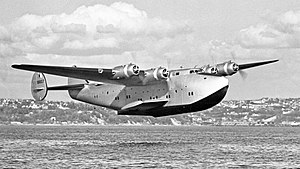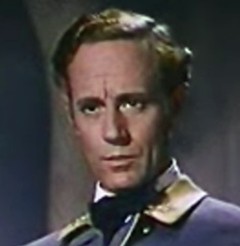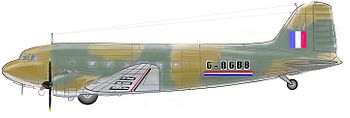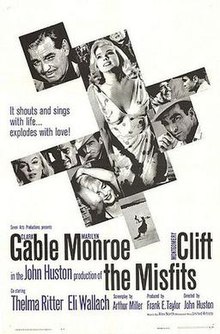
Lesley Howard – middle – played Professor Henry Higgins in the 1938 film Pygmalion.
* * * *
Leslie Howard was best known for playing Ashley Wilkes in 1939’s Gone with the Wind. (As the man Scarlett O’Hara was obsessed with.) At that point Howard was a mere 46 years old. And – while no one could know at the time – he had only four more years to live. In June 1943 his passenger airliner was shot down over the Bay of Biscay, between Portugal and England. According to one theory, “he” got shot down because the Nazis thought he was a British spy.
Howard’s airliner did get “shot down by the Luftwaffe,” but we may never know if he was really a British spy or if this was a case of mistaken identity. Even so, the question itself is intriguing.
 That airliner was shot down some nine months after the release of Howard’s 1942 movie Spitfire. (A poster is shown at left.) And his death did come about under suspicious circumstances.There’s more on that later, but first a word about how I learned about this mysterious death. In August 2015 I’d flown out to Utah for to visit my brother, and the night before I was to fly back we watched “Spitfire.” There’s more detail in the notes, but watching that movie got me on the path to learning about how Howard died so mysteriously.
That airliner was shot down some nine months after the release of Howard’s 1942 movie Spitfire. (A poster is shown at left.) And his death did come about under suspicious circumstances.There’s more on that later, but first a word about how I learned about this mysterious death. In August 2015 I’d flown out to Utah for to visit my brother, and the night before I was to fly back we watched “Spitfire.” There’s more detail in the notes, but watching that movie got me on the path to learning about how Howard died so mysteriously.
Spitfire was originally called The First of the Few in Britain. (The name was changed to “Spitfire” for American audiences.) Howard played “R.J. Mitchell, who designed the Supermarine Spitfire.” The British title alluded to Winston Churchill‘s memorable speech, attributing victory in the Battle of Britain to “the few.” (That is, the few men who piloted British fighters in the battle, and especially those who flew the Spitfire.) As Churchill put it, “Never in the field of human conflict was so much owed by so many to so few.”
 The film came out in Britain on September 12, 1942. Less than nine months later – “on or about” June 1, 1943 – Howard’s airliner was attacked by eight Luftwaffe Junkers Ju 88C6 fighter aircraft. The airliner – with 16 other passengers and crew – was attacked some 500 miles west of Bordeaux, France. The plane – or parts of it – came down in the Bay of Biscay, some 200 miles north of La Coruña, on the far northwestern tip of Spain.
The film came out in Britain on September 12, 1942. Less than nine months later – “on or about” June 1, 1943 – Howard’s airliner was attacked by eight Luftwaffe Junkers Ju 88C6 fighter aircraft. The airliner – with 16 other passengers and crew – was attacked some 500 miles west of Bordeaux, France. The plane – or parts of it – came down in the Bay of Biscay, some 200 miles north of La Coruña, on the far northwestern tip of Spain.
As to why the Luftwaffe shot down the airliner, here’s what Wikipedia said of Howard:
He was active in anti-German propaganda and reputedly involved with British or Allied Intelligence, which may have led to his death in 1943[. He] was shot down over the Bay of Biscay, sparking conspiracy theories regarding his death.
There was an alternate theory: That the Germans were really after Winston Churchill.
During the early years of World War II, Churchill routinely flew over the Bay of Biscay. By June, 1943, he was just finishing up a month-long trip to North Africa, including an inter-Allied conference in Algiers. The North Africa Campaign was just ending, and Allied leaders were planning the invasion of Sicily and Italy. The normal stop-over for such trips from North Africa to London was Lisbon, in ostensibly-neutral Portugal. (Often via Gibraltar.)
But also during the war, Lisbon was a hotbed of “trade, conspiracy, and subterfuge.” (Note that Lisbon was the destination of refugees and reprobates alike in the movie Casablanca.)
When Churchill took such flights – to and from London and/or North Africa via Lisbon – he was accompanied by a single bodyguard, Detective Inspector Walter H. Thompson. Thompson was tall and slender, and looked much like Howard. But in a strange twist, when Howard took his flight from Lisbon, he was accompanied by a close friend and business manager, Alfred Chenhalls. And to some people, Chenhalls looked “Churchillesque.” Which brings up this:
A long-standing hypothesis states that the Germans believed that Prime Minister Winston Churchill, was on board the flight. Churchill, in his autobiography, expressed sorrow that a mistake about his activities might have cost Howard his life.
See also “Churchill’s Bodyguard,” the BBC television series that suggested German intelligence agents knew of Churchill’s comings and goings from the area. On that note, Detective Thompson later wrote that Churchill often seemed clairvoyant about threats to his safety. And according to Thompson, Churchill had a premonition about his proposed flight over the Bay of Biscay on June 1, 1943, and so changed his departure to the following day.
Thus because of a perceived threat to his safety, Churchill changed his planned flight home:
Full of confidence, the Prime Minister flies home. And unwittingly causes a tragedy. Aware of his presence in North Africa, the Germans have prepared a trap. Their watchful agents in Lisbon report the departure of a thickset gentleman smoking a big cigar aboard a commercial aircraft leaving on a scheduled flight. Shortly after take-off it is pounced on by a German fighter [sic] and shot down with ridiculous ease. Among its fourteen passengers is film star Leslie Howard. The innocent cause of their death is a brilliant accountant and amateur musician called Alfred Chenhalls, whose resemblance to Churchill is superficial merely.
 (TVY 186) William Manchester‘s book The Last Lion added some telling details. He indicated that on June 4, 1943, Churchill boarded an Avro York for the flight to Gibraltar, from Algiers. He said Churchill planned to transfer at Gibraltar to a more-comfortable “Boeing flying boat [seen at left] for the final leg of the trip,” to London. But bad weather forced him to transfer to a B-24 Liberator instead. And there was some other confusion:
(TVY 186) William Manchester‘s book The Last Lion added some telling details. He indicated that on June 4, 1943, Churchill boarded an Avro York for the flight to Gibraltar, from Algiers. He said Churchill planned to transfer at Gibraltar to a more-comfortable “Boeing flying boat [seen at left] for the final leg of the trip,” to London. But bad weather forced him to transfer to a B-24 Liberator instead. And there was some other confusion:
That day, a German spy at the Lisbon airport reported to his superiors that a thickset man smoking a cigar had been seen boarding a commercial flight, another flying boat, destination London. Phone calls were made, German fighter aircraft scrambled. The hapless aircraft was shot down over the sea, killing all fourteen passengers, including the popular screen actor Leslie Howard.
According to Manchester, when Churchill got back to London he noted the brutality of the Germans, as exemplified by the attack on Howard’s airliner. But – he said – their brutality “was matched only by the stupidity of their agents.”
(Just as an aside, Manchester said this latest incident “unsettled Britons,” who “felt ill at ease” about Churchill’s being away from the country for a full month. They were equally ill at ease about his taking such unprotected flights so close to enemy territory.)
Roy Jenkins made a similar point in his biography of Churchill. He wrote that Churchill flew back to London “on the night of 4-5 June (1943),” and that the journey was without incident, except for bad weather. That in turn meant that Churchill couldn’t transfer to a “more comfortable flying boat,” but had to continue by uncomfortable bomber. (The B-24.)
Later that same day however another Pan American flying boat did take off from Lisbon for Plymouth and was shot down with the deaths of a full load of passengers, including Leslie Howard of Scarlet Pimpernel fame. In the same month a Liberator bomber (a companion to Churchill’s plane) flying from Gibraltar to England was also shot down, with the death of General Sikorski, the head of the Polish forces, and two accompanying British MPs.
The point being that Churchill appeared to be taking unnecessary risks. (Note also that the two “MPs” in this case were Members of Parliament.)
But there were other theories as well. According to the “Churchill” theory, the German intelligence agents in and around Lisbon were really stupid. But according to some alternate theories, those agents knew exactly what they were doing.
 One such theory had it that Howard was on a top-secret mission – for Churchill – to persuade Spain’s Francisco Franco not to join the Axis powers, Germany and Italy. (Spain was officially neutral at the time.) Howard’s go-between was said to be Conchita Montenegro (at right), with whom he’d ostensibly had a torrid love affair.
One such theory had it that Howard was on a top-secret mission – for Churchill – to persuade Spain’s Francisco Franco not to join the Axis powers, Germany and Italy. (Spain was officially neutral at the time.) Howard’s go-between was said to be Conchita Montenegro (at right), with whom he’d ostensibly had a torrid love affair.
(Not to mention Tallulah Bankhead and Merle Oberon, two of his other leading ladies. While he was said to be something of a ladies’ man at the time, Howard once quipped that he “didn’t chase women but … couldn’t always be bothered to run away” from them either.)
Other sources indicate that Howard’s successful anti-Nazi activities in the early years of World War Two “enraged Nazi propaganda minister Joseph Goebbels, who called Howard ‘Britain’s most dangerous propagandist,’” and that Howard also worked for British Intelligence.
Still other sources note another passenger on Howard’s airliner, “leading anti-Nazi activist Wilfrid Israel, who had helped Jewish refugees escape from the Holocaust.” You can see even more theories about this or these mysterious death(s) in the notes, but all of them lead to this thought: To think, some people thought those years were better and simpler times…
* * * *  “Ashley Wilkes,” anti-Nazi agitator?
“Ashley Wilkes,” anti-Nazi agitator?
* * * *
The upper image is courtesy of Leslie Howard (actor) – Wikipedia, the free encyclopedia. I changed to this image on January 5, 2016, after reviewing the post for a New Year’s “retrospective.” That look-back showed a foul-up in the image-transfer, originally from The First of the Few – Wikipedia. That’s where the image to the left of the paragraph beginning “His airliner was shot down” came from.
Note also that while some sources said Howard’s airliner was shot down on June 1, others give the date as June 4, 1943. Thus the phrase “on or about” June 1, 1943.
Here’s what I wrote in the original post, back in 2015. “In case you hadn’t noticed, I’m back in the saddle after three weeks out of town. (Part of that time was spent on the Columbia River, near Astoria, on unfinished canoe-trip business…) And it was only during that three-week hiatus – from home and daily routine – that I found out there were mysterious circumstances around Leslie Howard’s death. (Aboard an airliner like the one below right.) That happened because my brother is more delightfully retro than [me…]
 “[T]he night before I took my own commercial flight back home to God’s Country – the outskirts of Atlanta – we watched an old black-and-white movie: 1942’s Spitfire, starring Leslie Howard… On VHS no less, while enjoying some of Utah’s famed 3.2 beers…” The “airliner” image is courtesy of BOAC Flight 777 – Wikipedia, noted further below.
“[T]he night before I took my own commercial flight back home to God’s Country – the outskirts of Atlanta – we watched an old black-and-white movie: 1942’s Spitfire, starring Leslie Howard… On VHS no less, while enjoying some of Utah’s famed 3.2 beers…” The “airliner” image is courtesy of BOAC Flight 777 – Wikipedia, noted further below.
Re: “The film was released … 1942.” See First of the Few (1942) | Inafferrabile [sic] Leslie Howard. The site said in the U.S., Spitfire was released on June 12, 1943, “a few days after Leslie’s death.”
Re: 3.2 beer. See The Legacy of 3.2% Beer | The Society of Wine and Jurisprudence. The site said such beer is a “relic” of Prohibition. “In an attempt to limit the availability of higher-octane beverages, 3.2% is currently the only beverage allowed for sale at grocery stores in Colorado, Utah, and several other states.” (E.A.)
Re: “German fighters,” as to the Junkers Ju 88C6. As Wikipedia noted, a fighter aircraft is a “military aircraft designed primarily for air-to-air combat against other aircraft, as opposed to bombers and attack aircraft.” The Ju 88C6 was a “twin-engined multirole combat aircraft,” designed to be “too fast for any of the fighters of its era to intercept.” It was used in roles including but not limited to “night fighter … heavy fighter and even, during the closing stages of the conflict in Europe, as a flying bomb.”
That there were eight Ju 88C6s came from the article, List of airliner shootdown incidents – Wikipedia.
“Full of confidence … TVY.” See Winston Churchill: The Valiant Years, Jack Le Vien and John Lord, Bernard Geis and Associates (1962), at page 186. Note also:
1) Manchester’s “Last Lion…” See The Last Lion[:] Winston Churchill Defender of the Realm 1940-1965, William Manchester and Paul Reid, Little, Brown and Company (2012), pages 688-89.
2) William Manchester – noted American author, biographer and historian – died in 2004, while still at work on Last Lion. He chose his friend Paul Reid to finish the work. As Reid himself noted, Manchester began this “third and final volume of his biography of Winston Churchill” in 1988. Reid indicated that Manchester’s research on the book was complete but that he’d written only some 100 pages between 1988 and 1998, due to increasingly poor health. After Manchester died, Reid began the process of completing the book. See also Wikipedia:
Following the death of his wife in 1998, Manchester suffered from two strokes. He announced that he would not be able to complete his planned third volume of his three part-biography of Churchill, The Last Lion: Winston Spencer Churchill: Defender of the Realm, 1940-1965. He was also initially reluctant to collaborate with anyone to finish to work. In October 2003, Manchester asked Paul Reid, a friend and writer for The Palm Beach Post, to complete the Churchill biography.
Re: Roy Jenkins. See Churchill[:] A Biography, Farrar, Strauss and Giroux (2001), at pages 712-13. For what it’s worth, Jenkins put the “cumulative risk to which Churchill’s manifold journeys exposed him” at some 30 per cent.
Re: “flying boat.” The airliner in question was built by Boeing, flown by Pan American Airways and called the Clipper: “Twelve Clippers were built; nine were brought into service for Pan Am and later transferred to the U.S. military. The remaining three were sold to British Overseas Airways Corporation (BOAC) by Pan Am and delivered in early 1941. (BOAC‘s 3 Short S.26 transoceanic flying-boats had been requisitioned by the RAF).” See Boeing 314 Clipper – Wikipedia.
As to other theories, including that Howard’s plane was shot down because another passenger was “leading anti-Nazi activist Wilfrid Israel: Israel was a “friend of Albert Einstein, the philosopher Martin Buber, and Chaim Weizmann, later the first president of the state of Israel.” Wikipedia indicated that in the wake of Kristallnacht – the 1938 pogrom or “night of broken glass” in Germany – Wilfrid Israel took an active role, contacting among others “the Council for German Jewry in London, informing them that extraordinary measures must now be taken to save at least the children.” Regardless of such theories why this particular airliner was shot down, this fact remains: The tragedy made Howard “the first cast member from Gone With The Wind to die.”
 But other cast members lived long and productive lives. For example, Vivien Leigh – who played Scarlett O’Hara) – lived on until 1967. Olivia de Havilland – who played Melanie Hamilton, Scarlett’s rival and the cousin Ashley married – is still alive and has been living in Paris since 1960. And it was only in 1960 that Clark Gable died.
But other cast members lived long and productive lives. For example, Vivien Leigh – who played Scarlett O’Hara) – lived on until 1967. Olivia de Havilland – who played Melanie Hamilton, Scarlett’s rival and the cousin Ashley married – is still alive and has been living in Paris since 1960. And it was only in 1960 that Clark Gable died.
Gable played Rhett Butler in GWTW, but went on to numerous other movie roles including The Misfits, his final screen appearance. That movie also starred Marilyn Monroe. (At the time she was going through a “breakdown” of her marriage to writer Arthur Miller. Miller wrote the Misfits screenplay, and “revised the script throughout the shoot as the concepts of the film developed.”)
Monroe herself died on August 5, 1962 – at age 36 – a little over a year after the release of Misfits on February 1, 1961. The coroner listed the cause of death as “acute barbiturate poisoning” and/or “probable suicide,” but there were other theories here too:
Many theories, including murder, circulated about the circumstances of her death and the timeline after the body was found. Some conspiracy theories involved John and Robert Kennedy, while other theories suggested CIA or Mafia complicity. It was reported that President Kennedy was the last person Monroe called.
The “Conchita” image is courtesy of www.flickriver.com/photos. Wikipedia added this:
Following a rare interview with Montenegro shortly before her death, Spanish author José Rey-Ximena claims that British actor Leslie Howard used her to get close to Spanish dictator Franco after being given the special mission by Winston Churchill. She claimed that she used her husband’s influence to secure a meeting between the British actor and the Spanish dictator. “Thanks to him … Spain was persuaded to stay out of the war.” (E.A.)
Re: Franco and Spain’s neutrality. See Francisco Franco – Wikipedia, the free encyclopedia, which noted that on “23 October 1940 Hitler and Franco met in Hendaye, France, to discuss the possibility of Spain’s entry on the side of the Axis. However, Franco’s demands, which included food, military equipment, and Spanish control of Gibraltar and French North Africa proved too much for Hitler.”
Note that an agitator is someone who “actively supports some ideology or movement with speeches and especially actions.” The term originally referred to elected soldier-representatives of “the New Model Army of Oliver Cromwell, during the English Civil War. They were also known as adjutators.” See Wikipedia, the free encyclopedia.
* * * *
Other sources for this post include Leslie Howard (actor), Ashley Wilkes, and Gone with the Wind (film) – Wikipedia, the free encyclopedia, as well as the following:
See Clarecolvin.com/ian-colvin/flight-777-the-mystery-of-leslie-howard:
He was travelling with his tax adviser, cigar-smoking Alfred Chenhalls, who bore a resemblance to Winston Churchill – Churchill was at that time about to fly back from an Allied conference in North Africa. Also on board was leading anti-Nazi activist Wilfrid Israel, who had helped Jewish refugees escape from the Holocaust.
See also BOAC Flight 777 – Wikipedia, which noted that “the Douglas DC-3 lost in this attack had twice survived attacks by Luftwaffe fighters in November 1942 and April 1943.”
The Shootdown of Leslie Howard | Defense Media Network listed the date as June 1, and added:
Never entirely comfortable with Hollywood life, when war broke out, Howard, a Jew, decided to return to England and apply his fame and talent to a higher calling – helping his country fight the Axis. Howard starred, directed, and produced anti-German war films [like Spitfire] and radio broadcasts, and conducted lecture tours. His success enraged Nazi propaganda minister Joseph Goebbels, who called Howard “Britain’s most dangerous propagandist…” What the public didn’t know, though the Nazis did, was that Howard also worked for British Intelligence.
Note also the critical British base at Gibraltar, which played a key role in Churchill’s travels to and from North Africa. The base guarded the entrance to the Mediterranean Sea, where the Strait of Gibraltar is a mere eight miles wide or less. The base was “used primarily as a training area … and as a stopover for aircraft and ships en route to and from deployments East of Suez or Africa.”
And finally see The actor, the Jew and Churchill’s double. – Eye on Spain, and also Churchill A Photographic Portrait, by Martin Gilbert, Houghton Mifflin (1974):
1) Photograph 292 in Portrait shows Churchill standing between U.S. General George Marshall and Field Marshal Montgomery, with the caption: “While in Algiers, Churchill finalized the plans for the invasion of Sicily and Italy with the British and American leaders. This photograph, taken on 3 June 1943, was annotated by General Montgomery.” Montgomery later recalled, “Winston wanted me to say the Sicilian invasion would be all right. But I wouldn’t.” Despite Montgomery’s doubts, the Allied invasion liberated Sicily in some six weeks. (July 10-August 17, 1943.)